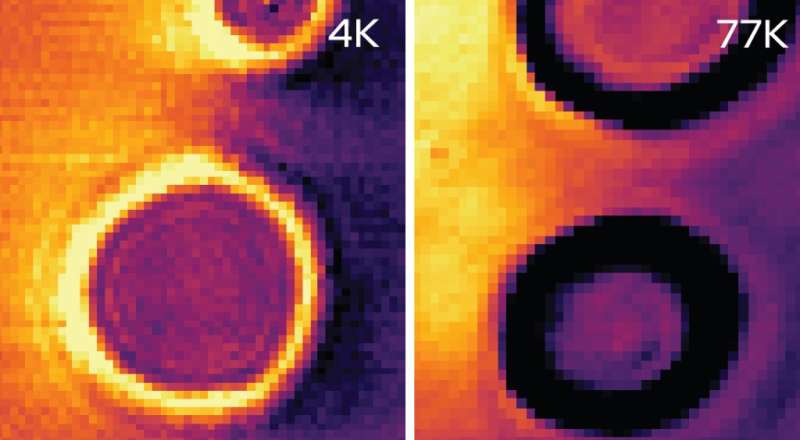This article has been reviewed according to Science X's editorial process and policies. Editors have highlighted the following attributes while ensuring the content's credibility:
fact-checked
peer-reviewed publication
trusted source
proofread
Smooth sailing for electrons in graphene: Measuring fluid-like flow at nanometer resolution

Physicists at the University of Wisconsin-Madison have directly measured the fluid-like flow of electrons in graphene at nanometer resolution for the first time. The results appear in the journal Science today.
Graphene, an atom-thick sheet of carbon arranged in a honeycomb pattern, is an especially pure electrical conductor, making it an ideal material to study electron flow with very low resistance. Here, researchers intentionally add impurities at known distances, and find that electron flow changes from gas-like to fluid-like as the temperature rises.
"All conductive materials contain impurities and imperfections that block electron flow, which causes resistance. Historically, people have taken a low-resolution approach to identifying where resistance comes from," says Zach Krebs, a physics graduate student at UW-Madison and co-lead author of the study. "In this study, we image how charge flows around an impurity and actually see how that impurity blocks current and causes resistance, which is something that hasn't been done before to distinguish gas-like and fluid-like electron flow."
The results have applications in developing new, low-resistance materials, where electrical transport would be more efficient.
The study used a technique known as scanning tunneling potentiometry (STP) and the 2D material graphene. The researchers intentionally introduced obstacles in the graphene, spaced at controlled distances, and then applied a current across the sheet. Using STP, they measured the voltage with nanometer resolution at all points on the graphene, producing a 2D map of the electron flow pattern (higher voltage = more electrons). No matter the obstacle spacing, the drop in voltage through the channel was much lower at a higher temperature (77 Kelvin) vs. a lower temperature (4 Kelvin), indicating more electrons were passing through (lower resistance).
"We did a quantitative analysis [of the voltage map] and found that at the higher temperature, the resistance is much lower in the channel. The electrons were flowing more freely and fluid-like," Krebs says. "Graphene is so clean that we're forcing the electrons to interact with each other before they interact with anything else, and that is crucial in getting them to behave like a fluid."
The rock and stream analogy
At temperatures near absolute zero, electrons in graphene behave like a gas: they diffuse in all directions and are more likely to hit obstacles than they are to interact with each other. Resistance is higher, and electron flow is relatively inefficient.
At higher temperatures—77 K, or minus 196 C—the fluid-like behavior of electron flow means they are interacting with each other more than they are hitting obstacles, flowing like water between two rocks in the middle of a stream. It is as if the electrons are communicating information about the obstacle to each other and diverting around the rocks. Resistance is lower, and electron flow is more efficient.
Former UW-Madison graduate student Wyatt Behn is a co-first author on this study, conducted in physics professor Victor Brar's group.
More information: Zachary J. Krebs et al, Imaging the breaking of electrostatic dams in graphene for ballistic and viscous fluids, Science (2023). DOI: 10.1126/science.abm6073
Journal information: Science
Provided by University of Wisconsin-Madison




















